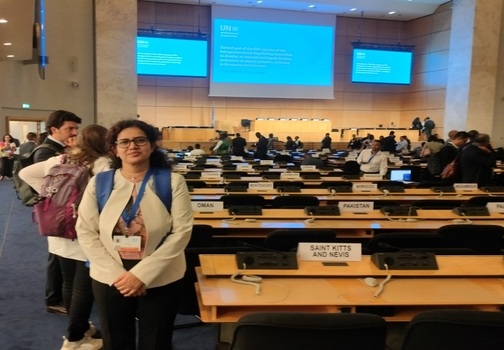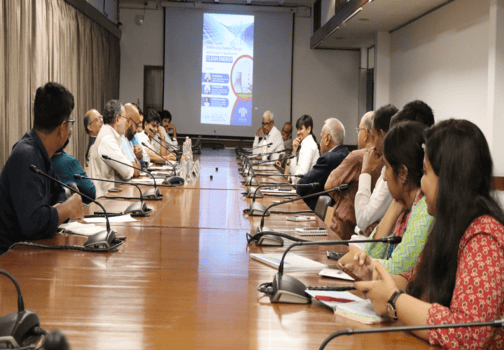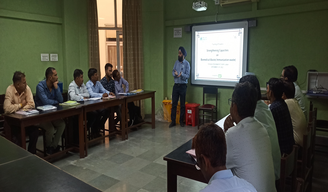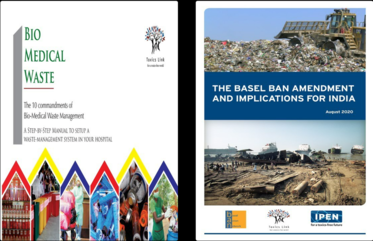Discharge of Chemical-laden Water into the Rivers
GOVERNMENT OF INDIA
MINISTRY OF ENVIRONMENT, FOREST AND CLIMATE CHANGE
LOK SABHA
UNSTARRED QUESTION NO. 2195
TO BE ANSWERED ON: 09.12.2024
Discharge of Chemical-laden Water into the Rivers
2195. SHRI TARIQ ANWAR:
Will the Minister of ENVIRONMENT, FOREST AND CLIMATE CHANGE be pleased to state:
(a) the action plans and fund allocations for the restoration and conservation of polluted river stretches in the State of Bihar;
(b) the impact of climate change on the population of Bihar along with the policies and action plans developed for different locations and hydrological conditions;
(c) the details of investment made in climate change-related studies in the country during the last five years along with the recommendations and adaptations;
(d) the details of percentage of rainfall stations in the State of Bihar are non-functional;
(e) the current status of groundwater in the State of Bihar as reported by the Central Ground Water Board (CGWB);
(f) the details of groundwater blocks in the State of Bihar are contaminated during the last five years, along with the details of investment made to provide clean water to affected populations, project-wise; and
(g) whether the Government has conducted or sponsored any studies to assess the extent of loss due to climate change in the State of Bihar?
ANSWER
MINISTER OF STATE IN THE MINISTRY OF ENVIRONMENT, FOREST AND CLIMATE CHANGE
(SHRI KIRTI VARDHAN SINGH)
(a)The Government of India (GoI) launched the Namami Gange Programme (NGP) in 2014-15 for the rejuvenation of river Ganga and its tributaries for five years, up to March 2021 that has been further extended to March 2026. In the State of Bihar, 38 Sewerage infrastructure projects have been undertaken at a cost of ₹ 7,089.26 crore to create 803 million liters per day(MLD) of sewage treatment capacity and laying of 1,750.64 km of sewer network. Out of which, 17 projects have been completed and made
operational, resulting in the creation & rehabilitation of 335 MLD of STP capacity and laying of 1366.24 kms sewerage network.
Further, Central Pollution Control Board (CPCB) in coordination with State Pollution Control Boards (SPCBs) / Pollution Control Committees (PCCs) monitors water quality under National Water Quality rivers in the country at 2155 locations, out of which 96 locations on 22 rivers are monitored in Bihar. The water quality data under National Water Quality Monitoring Programme (NWMP) is utilized for identification of Polluted River Stretches (PRS) based on the level of organic load which is measured in terms of Biochemical Oxygen Demand (BOD) concentration. Locations/stretches of rivers which are not meeting the Primary Water Quality criterion for outdoor bathing for Biochemical Oxygen Demand (BOD) parameter (indicator of organic pollution) are identified as polluted location/ stretches. The PRS are classified under Priority Class I to Priority Class V,
Priority I being most polluted with BOD value of more than 30 mg/l and Priority V being least polluted with BOD ranging between 3 – 6 mg/l. Based on water quality data of year 2016 & 2017, CPCB identified 351 PRS including on major rivers during the year 2018, out of which 06 PRS are in Bihar as under:
For rejuvenation of 351 polluted river stretches identified by CPCB during the year 2018, action plans were prepared by four-member Committee called “River Rejuvenation Committee’’ (RRC) constituted by the respective State Government/ UT Administration including the state of Bihar. It works under the overall supervision and coordination of Principal Secretary, Environment of the concerned State /Union Territory for bringing all the polluted river stretches identified by CPCB fit for bathing purposes (i.e. BOD ˂ 3 mg/L and FC ˂ 500 MPN/100 mL). Action plans covers aspects such as Source control (Municipal sewage management, Industrial pollution control, Waste management), River catchment/Basin Management (Adoption of good irrigation practices, Utilization of treated sewage, Ground water recharge aspects), Flood Plain Zone protection and its management (Setting up of bio-diversity parks, Removal of encroachments, Rain water harvesting, Plantation on both sides of the river), Ecological/Environmental Flow (E-Flow) and Watershed management.
Implementation of time-bound action plans have been assigned to State Government Departments/ UT Administration Departments and are responsible for rejuvenation of polluted river stretches identified in the respective State/UT under the overall supervision and coordination of Principal Secretary, Environment of the concerned State/Union Territory. Progress of implementation of action plans is reviewed by the RRC’s at State Level and by Central Monitoring Committee (CMC) at Central Level.
(b) and (c) The National Action Plan on Climate Change (NAPCC) provides a framework for India’s climate
actions and comprises of missions in specific areas of solar energy, enhanced energy efficiency, sustainable habitat, water, sustaining Himalayan ecosystems, Green India, sustainable agriculture, human health and strategic knowledge for climate change. Thirty-four States/Union Territories (UTs) including the State of Bihar have prepared their State Action Plans on Climate Change (SAPCC) in line with the NAPCC taking into account the State specific issues relating to climate change. The Bihar’s SAPCC aims to enhance resilience to climate change while promoting sustainable development.
As part of the Third National Communication (TNC) and Initial Adaptation Communication (IAC) submitted to the UNFCCC in 2023, India conducted studies on biodiversity, agriculture, water resources, coastal and marine ecosystems, urban infrastructure, and human health. These efforts highlighted the importance of strengthening climate modeling, localized vulnerability assessments, and hydro-meteorological observation networks.
The TNC and IAC also highlighted ecosystem-based strategies like watershed management, mangrove restoration, and coastal community relocation to mitigate risks. Promoting indigenous technologies under “Make in India,” improving rural credit access, and embedding adaptation into development plans are key to resilience. Agronomic adjustments, adaptive water management, and energy-efficient housing aim to reduce vulnerabilities, diversify livelihoods, and foster climateresilient growth.
(d) Currently, the state of Bihar has a network of total of 474 manual rainfall stations and all are functional. Further, out of a total of 46 Automated Weather Stations (AWS) for rainfall monitoring in Bihar, 10 AWS stations are non-functional.
(e) and (f) Central Ground Water Board (CGWB), Mid-Eastern Region (MER), Patna, carries out periodic
monitoring of water level four times a year (January, May, August, and November) through its established Hydrograph Network Stations (HNS) across the entire state to know the ground water regime of the State. The monitoring carried out in May 2024, shows that the depth to water level in Bihar ranged from 0.8 to 13.85 meters below ground level (bgl) and 97 % of wells are within 10 m below ground level (bgl).
Decadal Fluctuation (Pre Monsoon 2023 w.r.t. mean of 2013-2022) are showing 57.62 % rise, while 42.37 % showing fall, out of which 33.12% are within 0-2 m range. Decadal Fluctuation (Post Monsoon 2023 w.r.t. mean of 2013-2022) are showing 44.66 % rise, while 59.33 % showing fall, out of which 51.57% are within 0-2 m range.
With respect to the assessment of Dynamic Groundwater Resources, the latest assessment (as on 2024) shows that the overall stage of ground water extraction in Bihar is 45.54%. Out of 535 assessment units (block), 473 (89.53 %) are in Safe category, while 04 (0.74 %) are in Over Exploited category. 09 (1.68 %) are in Critical category and 49 (9.15 %) are in Semi Critical category.
Central Ground Water Board (CGWB) is generating ground water quality data periodically during pre-and post-monsoon period through its established Hydrograph Network Stations (HNS) across the entire state. During other studies/ special studies sampling and analysis of arsenic contamination were also carried out. On the basis of chemical analysis of ground water samples collected, the blocks which are partly affected by Arsenic and Fluoride contamination are given as Annexure-I.
CGWB, MER, Patna has constructed 28 Arsenic safe tubewells in Arsenic affected areas of 8 districts (Buxar, Bhojpur, Bhagalpur, Darbhanga, Patna, Samastipur, Saran and Begusarai) through in-house exploratory drilling. These wells have been constructed tapping the deeper arsenic safe aquifers avoiding contaminated aquifers (by clay/cement sealing at appropriate depth against clay layer). In addition, 40 Arsenic safe tubewells were constructed in Arsenic affected areas of Buxar district, Bihar and also, these wells have been handed over to user agencies/ Public Health Engineering Department (PHED), Government of Bihar, for providing drinking water. The details are enclosed as Annexure II. It is informed that PHED, Government of Bihar provides safe potable water in affected rural populations through arsenic and fluoride removal plants and also through Multi Village Schemes.
(g)
Any specific study to assess the extent of loss due to climate change in the State of Bihar has not
been conducted.






